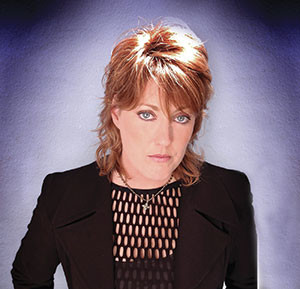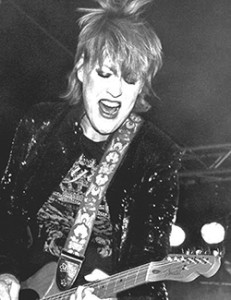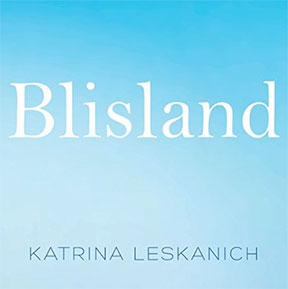
Katrina Leskanich will be entertaining at Johnnie D’s on Wednesday, March 18.
By Blake Maddux
In the summer of 1985, Katrina Leskanich and her band The Waves were ubiquitous on radio and MTV thanks to the worldwide smash hit Walking on Sunshine.
Thirty years later, the song is no less familiar to subsequent generations due to its continued rotation on radio and inclusion in countless movies and television shows. (In 2011, Katrina & The Waves threatened legal action against Michelle Bachman after the Minnesota congresswoman played the song at a rally).
It addition to her work with The Waves, who enjoyed a bit of a resurgence in 1997 upon being named the United Kingdom’s winner of the Eurovision Song Contest, Leskanich has sung back-up vocals on songs by artists as diverse as Finnish hard rock band Hanoi Rocks, English progressive rock keyboardist Rick Wakeman, and Australian singer-songwriter Natalie Imbruglia.
Leskanich is currently preparing to tour the United States in support of the recently released Blisland, her first solo album in a decade. She will be performing at Johnny D’s on Wednesday, March 18.
Katrina, as she is more famously known, spoke to The Somerville Times by phone from her home in London, where – she says – “they have one snow plough” and “it is about 65 degrees.”
The Somerville Times: What are some of the more interesting or surprising instances in which you have heard Walking on Sunshine played?
Katrina Leskanich: American Psycho is one. That was a bit of a surprise, because it was done in such a kind of a cool, ironic way, and I thought, “Well, that’s sort of a refreshing take.” Dolly Parton’s cover of Walking on Sunshine, the mash-up with Beyoncé [on Glee] was good and interesting. Where it pops up in movies is always fun. I guess when people say it was played at somebody’s funeral is a little bit different, but I get it. People want to send their loved ones out on a high.
ST: What was your career with The Waves like prior to 1985?
KL: The song that got us recognized to begin with was a song called Going Down to Liverpool, and that was covered by The Bangles. They were signed on Columbia Records, and it was at a time when we were signed with Attic Records, which was a Canadian label. So we made a couple of albums for them and ended up touring Canada for three years until we started noticing people sitting in the corner, kind of dressed with dark shades on and in a suit, taking notes. Some would come and say hello afterwards and others would just leave. And there was suddenly this interest in us because I think people were wondering, “OK, The Bangles have got Going Down to Liverpool, now where does that song come from?”
We’d been together for five years before we had success with Walking on Sunshine. That’s a lot of gigs, that’s a lot of trial and error, that’s a lot of stinking it up, but of course you’re so hungry and you’re so happy that you’re just in the music business and able to do it. I was washing dishes on an American base [her father was a colonel in the United States Air Force] at the chow hall for five years during our rise. Our bass player was drilling holes in bowling balls for the bowling alley on base. Kimberley Rew was a postman, and Alex Cooper, our drummer, was working at a mortuary. He’s a really strong guy, so he was carrying dead bodies around.
ST: Did you release Walking on Sunshine with the expectation, or at least the hope, that it would break you worldwide?
 KL: Well, it was interesting when we started off that a song called Do You Want Crying? was supposed to be the first single and Capitol had identified that single, we were going to go with it, we made video for it. And Capitol sent out a demo tape to all the DJs that had four tracks on it. And the DJs came back and said, we don’t want to go with Do You Want Crying?, we want to go with the Sunshine song. It’s got the drums at the beginning that they could talk over and do the big announcement up to that “OWWW!” and that was kind of exciting for them. It was at time in 1985 when there were a lot English bands coming over, and we were part of that because two members of the group were English, plus the fact that we lived in England made everybody think that we were an English group. [Leskanich was born in Topeka, Kansas, and lived in eight different states before moving with her family to Europe in 1972 and to England four years later]
KL: Well, it was interesting when we started off that a song called Do You Want Crying? was supposed to be the first single and Capitol had identified that single, we were going to go with it, we made video for it. And Capitol sent out a demo tape to all the DJs that had four tracks on it. And the DJs came back and said, we don’t want to go with Do You Want Crying?, we want to go with the Sunshine song. It’s got the drums at the beginning that they could talk over and do the big announcement up to that “OWWW!” and that was kind of exciting for them. It was at time in 1985 when there were a lot English bands coming over, and we were part of that because two members of the group were English, plus the fact that we lived in England made everybody think that we were an English group. [Leskanich was born in Topeka, Kansas, and lived in eight different states before moving with her family to Europe in 1972 and to England four years later]
We were all really surprised because we thought Walking on Sunshine was more of a novelty song for us, because we thought we were really cool, you know. We thought we were The Velvet Underground, you know, like The Ramones. I thought I was [Velvet Underground vocalist] Nico with the black turtleneck and eyeliner. You can kind of see from the first album the vibe that we were going for: no smiling, taking it quite seriously. Then Walking on Sunshine hit and every TV show, every interview, everything that we did after that photographers would be like, “Come you guys, do some smiling. Do some jumping around! We’re gonna do this one on the beach. Take your sunglasses off. Why aren’t you guys smiling and being happy?”
ST: Did it require several takes in the studio? If so, how did you keep up the required amount of energy to get it right?
KL: I’ve got a very low boredom threshold. I would sing a song once, which was supposed to be like the run-through, and it would always end up being the one. And then I could never really be bothered to sing it many more times. That’s the first take, and even in the line where I go, “And I just can’t wait for the day when you know on my door,” I’m sort of smiling because at the time Vince de la Cruz, the bass player, was shooting a moon through the window of the control room into the studio. And that why I’ve got a smile on my face. I’ve got a smile on my voice, is what it should be.
ST: The last person whom I interviewed in advance of a show at Johnny D’s was Midge Ure. The two of you were on the Retro Futura tour last year along with The Thompson Twins and Howard Jones. How did you come to be part of that bill?
KL: They obviously needed a woman, so my phone rang and it’s the first time that my phone had rung for a gig in America in 20
years. It was the first time that I had performed there in 20 years. The Thompson Twins, Howard Jones, Midge Ure, it was a really good bill. And I thought, “Well, this will be fun and a good way of getting back into the American scene.” And also at the time, they were all coming with original material, and I thought, “Uh oh, I don’t have any original material!” So it really inspired me to get down and write all the material on Blisland, which is my new album. I wasn’t sure what was going to happen or how it was going to work out or what the process was going to be or anything, but I didn’t have too much time to sit around and contemplate, work it out, or labor over it, and so the writing for that came very, very quickly. And it sort of transformed my life: to finally, after 10 years of not recording any original material, writing something and releasing it as a record.
I saw that there was a chasm, there was an emptiness that needed to be filled by something. I wasn’t quite sure what it was or what it should be, and when I got down to writing the material for Blisland, I thought, this is it. This is what’s been missing from my life. I really do need to feel a part of the creative process of contributing something musically and not always being about something that retrospective or happened 30 years ago or whatever. So it’s been really fun. It’s hard work when you’re doing it on your own because you don’t have a deal, but at the same time the power that you get of having total control is quite fun.
ST: Had you worked or been in contact with any members of the Retro Futura tour in the 1980s?
KL: You pass these people. You do TV shows, especially in Germany, and you know they’re in the dressing room next you, but in the 80s nobody talked to anybody else. I’m only talking to people like Howard Jones and Tom Bailey from The Thompson Twins and Midge Ure now because everybody’s chilled out and everybody’s of a certain age where we’re all just so grateful that anybody like you would want to talk to us and take the time to find out stuff. It’s very precious, and also there’s a time limit, you know, your voice gives out or you’re too old to do it or you get sick or you lose interest or whatever. I’m really grateful for the way things worked out.
ST: Tell me about your book Peggy Lee Loves London.
KL: This is a photographic book. I’ve lived in London nearly 30 years. I have my cool spots, my favorites: pubs, bars, clubs, even bakeries, parks, whatever. I know all the coolest places to go. I took a picture of them and let my little poodle, Peggy Lee, be the model for them, because I don’t want to get my old mug in there. And it was just kind of a really fun thing to do.
ST: Do you have any plans for a follow-up?
KL: I was thinking about doing a book, Peggy Lee Loves America and have 50 pages in it and get a picture of her in some iconic situation relating to each American state and the say something about it, even if it’s really basic, like “The capital is this, the population is this, known for this,” and then just have a sweet little picture of her.
Katrina Leskanich. Wednesday, March 18 at Johnny D’s. Doors at 5:30, show at 7:30. $20 in advance, $25 day of show.
















Reader Comments